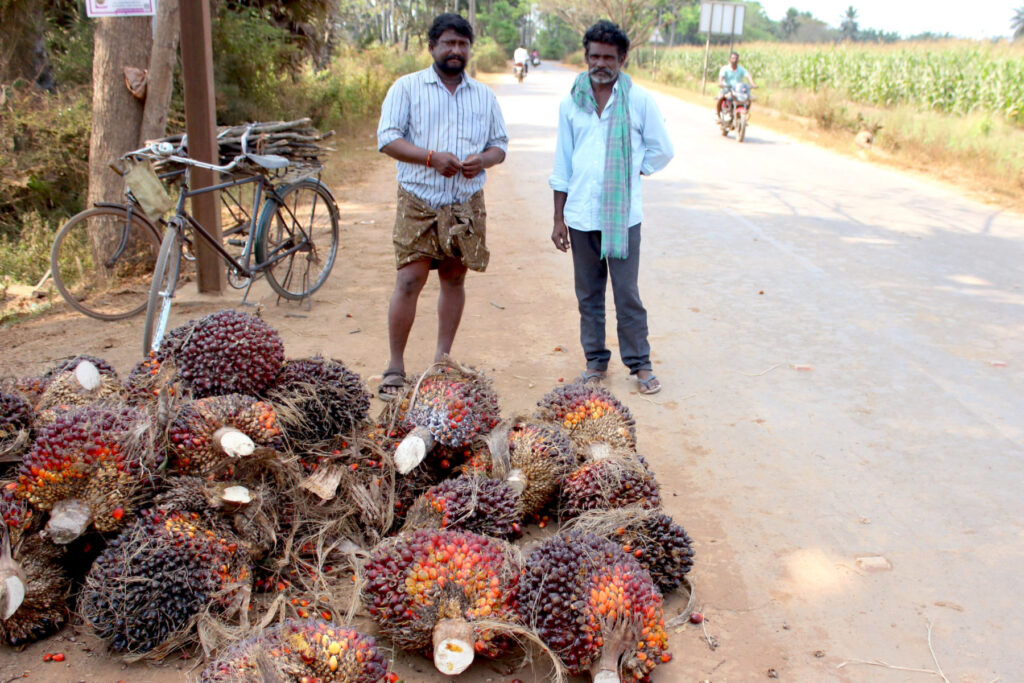India’s Palm Oil Drive Faces A Reality Check
Jul 1, 2023 | Pratirodh Bureau
Harvested palm oil fruit at a pick-up point in Sriramapuram, Andhra Pradesh (Image: Kevin Samuel / China Dialogue)
Palm oil has become essential to India’s food security in the past three decades, replacing other edible oils such as groundnut. About 90% of the 8.5 million tonnes of palm oil consumed in India is used in food or as cooking oil.
Today, India is the world’s second-largest consumer of palm oil after Indonesia, with one crucial difference: Indonesia produces most of the palm oil it consumes, while India produces nearly none. It spent USD 8.72 billion on palm oil imports in 2021.
In the same year, the Indian government set out to reverse this trend by encouraging farmers to grow oil palms, a potential win–win for local agriculture and the economy. It announced a nationwide campaign, the National Mission on Edible Oils – Oil Palm, that promised subsidies for fertilisers and support for the sector at large, including setting up irrigation systems and processing mills.
In 2019-20, India produced 270,000 tonnes of palm oil from 350,000 hectares of plantations. The mission aims to increase this to 1.12 million tonnes across 1 million hectares by 2025-26, and to 2.8 million tonnes across 6.6 million hectares by 2030.
But progress has been slow. Government responses to right to information requests revealed that 14 of the 22 states slated for increased oil palm cultivation do not have mills to process fruits into palm oil, and that area-wise palm oil expansion targets were not met in 2021-22 or 2022-23.
A Reality Check For ‘Aspirational Targets’
Oil palm fruits are highly perishable. They need to be crushed within two days of harvesting and ideally within one. The fact that many states do not have mills at all is therefore cause for concern.
It also seems like little is being done to set up any additional mills. In its response to this reporter, the government stated that new mills are being established in Arunachal Pradesh and Assam, while 12 states that do not yet have any of these facilities remain without prospective developments.
Progress on area-wise expansion has also been unimpressive. In the first year, 72% of the 29,422-hectare expansion target was achieved, while just 36% of the 2022-23 target was met (excluding the last month of March).
Experts have also raised concerns over the climatic conditions of some of the target areas. For example, in the north-east the plan proposes to rely on rainfall rather than irrigation. But annual rainfall in the region is lower than the 2,000–2,500 mm the crop would ideally get, and is not distributed evenly throughout the year. Climate change adds to the uncertainty. Research shows that the total rainfall in the region has decreased in the past 50 years, while the frequency of extreme rains has increased.
Siraj Hussain, former national agriculture secretary, said that the inclusion of states like Bihar and Uttar Pradesh in the expansion plans is “aspirational”. In the short term, it is unlikely that production will take off here, he said, because climatic conditions like rainfall patterns and humidity are not conducive to cultivating oil palm. The relevant state governments are also not as enthusiastic about providing subsidies for inputs like fertilisers and support for irrigation facilities, he added. Currently, they do not produce any palm oil.
Anupam Barik, a former commissioner with India’s agriculture ministry, said that various states including Madhya Pradesh, Maharashtra, West Bengal, Bihar and Uttar Pradesh have not been enthusiastic about the crop’s expansion.
Due to these uncertainties, profits for farmers who choose to switch to oil palm may not be guaranteed. Hussain said that, with such risks in mind, “the experience of farmers in states like Andhra Pradesh and Telangana [where oil palm cultivation has taken off] will be keenly watched.” At around 300,000 tonnes of palm oil per year, the state of Andhra Pradesh is India’s largest palm oil producer.
Lack Of Oil Palm Infrastructure
The presence of processing mills close to plantations is essential for a functioning supply chain, given the limited shelf life of the oil palm fruit. States located close to others with milling capacities and appropriate transportation facilities, such as Odisha, which shares a border with Andhra Pradesh, can still get the fruit processed in time. But what happens when these mills are saturated with the produce cultivated in the state? Some states, like those in the north-east, lack both milling capacity and road infrastructure to transport the fruits on time.
In order for a mill to be financially viable, “whoever is setting up a mill has to ensure that sufficient quantities of palm oil are grown,” said Hussain.
